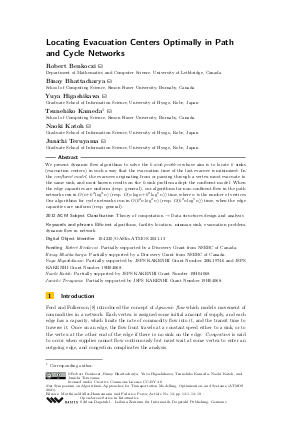Locating Evacuation Centers Optimally in Path and Cycle Networks
Authors Robert Benkoczi, Binay Bhattacharya, Yuya Higashikawa, Tsunehiko Kameda, Naoki Katoh, Junichi Teruyama
-
Part of:
Volume:
21st Symposium on Algorithmic Approaches for Transportation Modelling, Optimization, and Systems (ATMOS 2021)
Part of: Series: Open Access Series in Informatics (OASIcs)
Part of: Conference: Symposium on Algorithmic Approaches for Transportation Modelling, Optimization, and Systems (ATMOS) - License:
 Creative Commons Attribution 4.0 International license
Creative Commons Attribution 4.0 International license
- Publication Date: 2021-09-27
File

PDF
OASIcs.ATMOS.2021.13.pdf
- Filesize: 1.08 MB
- 19 pages
Document Identifiers
Subject Classification
ACM Subject Classification
- Theory of computation → Data structures design and analysis
Keywords
- Efficient algorithms
- facility location
- minmax sink
- evacuation problem
- dynamic flow in network
Metrics
- Access Statistics
-
Total Accesses (updated on a weekly basis)
0Document
0Metadata
Abstract
We present dynamic flow algorithms to solve the k-sink problem whose aim is to locate k sinks (evacuation centers) in such a way that the evacuation time of the last evacuee is minimized. In the confluent model, the evacuees originating from or passing through a vertex must evacuate to the same sink, and most known results on the k-sink problem adopt the confluent model. When the edge capacities are uniform (resp. general), our algorithms for non-confluent flow in the path networks run in O(n + k² log² n) (resp. O(n log(n) + k² log⁵ n)) time, where n is the number of vertices. Our algorithms for cycle networks run in O(k²n log² n) (resp. O(k²n log⁵ n)) time, when the edge capacities are uniform (resp. general).
Cite As Get BibTex
Robert Benkoczi, Binay Bhattacharya, Yuya Higashikawa, Tsunehiko Kameda, Naoki Katoh, and Junichi Teruyama. Locating Evacuation Centers Optimally in Path and Cycle Networks. In 21st Symposium on Algorithmic Approaches for Transportation Modelling, Optimization, and Systems (ATMOS 2021). Open Access Series in Informatics (OASIcs), Volume 96, pp. 13:1-13:19, Schloss Dagstuhl – Leibniz-Zentrum für Informatik (2021)
https://doi.org/10.4230/OASIcs.ATMOS.2021.13
BibTex
@InProceedings{benkoczi_et_al:OASIcs.ATMOS.2021.13,
author = {Benkoczi, Robert and Bhattacharya, Binay and Higashikawa, Yuya and Kameda, Tsunehiko and Katoh, Naoki and Teruyama, Junichi},
title = {{Locating Evacuation Centers Optimally in Path and Cycle Networks}},
booktitle = {21st Symposium on Algorithmic Approaches for Transportation Modelling, Optimization, and Systems (ATMOS 2021)},
pages = {13:1--13:19},
series = {Open Access Series in Informatics (OASIcs)},
ISBN = {978-3-95977-213-6},
ISSN = {2190-6807},
year = {2021},
volume = {96},
editor = {M\"{u}ller-Hannemann, Matthias and Perea, Federico},
publisher = {Schloss Dagstuhl -- Leibniz-Zentrum f{\"u}r Informatik},
address = {Dagstuhl, Germany},
URL = {https://drops.dagstuhl.de/entities/document/10.4230/OASIcs.ATMOS.2021.13},
URN = {urn:nbn:de:0030-drops-148825},
doi = {10.4230/OASIcs.ATMOS.2021.13},
annote = {Keywords: Efficient algorithms, facility location, minmax sink, evacuation problem, dynamic flow in network}
}
Author Details
Funding
- Benkoczi, Robert: Partially supported by a Discovery Grant from NSERC of Canada.
- Bhattacharya, Binay: Partially supported by a Discovery Grant from NSERC of Canada.
- Higashikawa, Yuya: Partially supported by JSPS KAKENHI Grant Number 20K19746 and JSPS KAKENHI Grant Number 19H04068.
- Katoh, Naoki: Partially supported by JSPS KAKENHI Grant Number 19H04068.
- Teruyama, Junichi: Partially supported by JSPS KAKENHI Grant Number 19H04068.
References
-
P.K. Agarwal and M. Sharir. Efficient algorithms for geometric optimization. ACM Computing Surveys, 30(4):412-458, 1998.

-
G.P. Arumugam, J. Augustine, M. Golin, Y. Higashikawa, N. Katoh, and P. Srikanthan. Optimal evacuation flows on dynamic paths with general edge capacities. CoRR abs/1606.07208, pages 1-37, 2016.

-
R. Benkoczi and R. Das. The min-max sink location problem on dynamic cycle networks. Unpublished manuscript, October 2018.

-
B. Bhattacharya, M. Golin, Y. Higashikawa, T. Kameda, and N. Katoh. Improved algorithms for computing k-sink on dynamic flow path networks. In Proc. Algorithms and Data Structures Symp., Springer-Verlag, LNCS 10389, pages 133-144, 2017.

-
B. Bhattacharya and T. Kameda. Improved algorithms for computing minmax regret sinks on path and tree networks. Theoretical Computer Science, 607:411-425, November 2015.

-
D. Chen and M.J. Golin. Minmax centered k-partitioning of trees and applications to sink evacuation with dynamic confluent flows. In CoRR abs/1803.09289, 2018.

-
R. Das. Minmax sink location problem on dynamic cycle networks. Master’s thesis, University, of Lethbridge, Lethbridge, Canada, 2018.

-
L.R. Ford and A.D.R. Fulkerson. Constructing maximal dynamic flows from static flows. Operations Research, 6(3):419-433, 1958.

-
M.J. Golin, H. Khodabande, and B. Qin. Non-approximability and polylogarithmic approximations of the single-sink unsplittable and confluent dynamic flow problems. In Proc. 28th Int'l Symp. on Algorithms and Computation (ISAAC), pages 41:1-41:13, 2017.

-
H.W. Hamacher and S.A. Tjandra. Mathematical modelling of evacuation problems: a state of the art. in: Pedestrian and Evacuation Dynamics, Springer Verlag,, pages 227-266, 2002.

-
Y. Higashikawa, M.J. Golin, and N. Katoh. Multiple sink location problems in dynamic path networks. Theoretical Computer Science, 607(1):2-15, 2015.

-
Y. Higashikawa and N. Katoh. A survey on facility location problems in dynamic networks. The Review of Socionetwork Strategies, 13:163-208, September 2019.

-
B. Hoppe and É. Tardos. The quickest transshipment problem. Mathematics of Operations Research, 25(1):36-62, 2000.

-
N. Kamiyama. Studies on Quickest Flow Problems in Dynamic Networks and Arborescence Problems in Directed Graphs: A Theoretical Approach to Evacuation Planning in Urban Areas. PhD thesis, Kyoto University, 2005.

-
S. Mamada, K. Makino, and S. Fujishige. Optimal sink location problem for dynamic flows in a tree network. IEICE Trans. Fundamentals, E85-A:1020-1025, 2002.

-
N. Megiddo. Combinatorial optimization with rational objective functions. Math. Oper. Res., 4:414-424, 1979.

-
M. Skutella. An introduction to network flows over time. In Research Trends in Combinatorial Optimization, W. Cook, L. Lovasz, and J.Vygen, Eds., pages 451-482. Springer Verlag, 2009.

